


Sources:
Let your horse sniff the aqua bag the first time and put it on without weight initially – possibly without a saddle as well. Remove the aqua bag when the horse is calm and comfortable with it.
Hold onto the aqua bag all the time, and preferably have someone help hold the horse, so you can quickly remove the aqua bag and calm the horse if it panics.
Once the horse is comfortable with the aqua bag on its back, you can try placing a saddle on and attaching the aqua bag to it, asking the horse to move forward and possibly fastening it loosely to the saddle.
If your horse is comfortable with the above, you can repeat the same procedure with water in the aqua bag. You do not need to fill it up completely – especially not at the beginning. Experiment with what works for you.
Be aware that your horse may react to both the feeling of weight and the sloshing sound of water in the aqua bag.
Once your horse is comfortable with the aqua bag on its back, you can start working with the horse and activate its back in the way you usually do. This could be through pole work or similar. Since there will be water on both sides of an aqua bag, it demands your horse's body awareness, abdominal muscles, coordination, and balance. Therefore, it can be relatively challenging training for your horse. Thus, you should not train with the aqua bag for long intervals.
As with many other kinds of horse training, you should proceed slowlY
The aqua bag was originally developed to improve the movements of professional wrestlers in Bulgaria. Normally they are filled with sand, but the version that can be used for your horse should be filled with water. It might sound a bit strange, that you can use a wrestling tool for your horse, but nevertheless, an aqua bag is a gentle way to train your horse.
That is, if you for instance are breaking in your horse, are rehabilitate after an injury, or you just want to train its back muscles in a gentle way, you can experiment with an aqua bag. It can easily be filled with water and can weigh up to 17 kg.
5. Aqua bag
Proceed cautiously if you use a massage tool. If your horse shows any signs of discomfort, always stop and respond – and possibly have it checked by a veterinarian. Never massage – with or without a tool – on your horse immediately after training, as it can be painful for the horse's muscles.
If your horse is comfortable with it, you can try running the massage tool gently over the horse and see if you can activate different parts of the body through touch. Then try to get your horse to move. Watch for changes in your horse's movements. Perhaps the movements have become larger and more powerful – but the opposite can also be an option.
Benefits of massage
Increases and improves blood circulation
Increases lymph circulation
Raises body temperature
Lowers blood pressure (by affecting the autonomic nervous system)
Increases elasticity in muscles and tendons
Prevents various issues in the entire musculoskeletal system
Increases interaction and closeness between you and your horse. Additionally, it helps improve your own condition when performing the massage.
When your horse is comfortable standing on the mat, you can gradually build upon it. For example, challenge your horse's balance on the mat by asking it to lift one leg or perform certain stretching exercises. Experiment with exercises that you would typically ask your horse to do from the ground. You can also try placing different numbers of legs on the mat, folding it completely or halfway to see how it affects the horse's body.
If the mat has a fun colour, it can also serve as environmental training for many horses. Therefore, you can experiment with placing it in different locations around the arena or on the track whilst riding. This way, your horse will suddenly experience how otherwise familiar surroundings may look different, because of the mat. This can help strengthen your horse's focus and concentration once it realizes that the distracting element is not dangerous.
Maybe you are already using the large Pilates ball when doing groundwork with your horse. But there is actually much more fitness equipment that you can use in the daily training of both you and your horse. Here are five suggestions for fitness equipment of varying difficulty levels that you and your horse can try to incorporate into your daily routine.
By Cæcilie Kallehave Jensen. Coverphoto: Ellen Sauer
Ellen and the horse Picasso with an aqua bag. Photo: Ellen Sauer
Pilates and exercise balls are probably not something you immediately associate with the stable. However, in reality, these – and many other items from the gym – can also be used in the stable. Read on and discover what and how!
Fitness equipment that can be used in the stable





It is not only humans who enjoy the benefits of massage; your horse will likely appreciate a session with a massage tool. However, it can never replace a massage from a trained equine bodyworker. Instead, it can be used as a supplement to your daily grooming and training routine.
You can experiment with using it in your groundwork or before riding. While massage often has a relaxing effect on many horses, it can also be used to activate your horse during groundwork by stimulating blood circulation. Before you begin, however, make sure you know where and how to massage the horse to avoid causing harm. Consult a trained body therapist for help.
4. Massage toolS
Unlike the Pilates ball, smaller balls can be used to increase the rider's body awareness. Place the small balls under the rider's seat in the saddle, helping you activate your pelvis and improve your seat.
While your horse is walking to warm up, try placing two small balls just under your seat bones. This will loosen the muscles around the seat bones and thighs, making it easier for you to get down and around your horse with your legs. Additionally, you will become more upright, providing a better – and healthier – position in the saddle, benefiting both you and your horse.
3. Balls underneath the seat
Most horse people have probably seen how amusing it can be when a horse runs around after a large Pilates ball. If the horse is comfortable with it and approaches the ball on its own, it can have a lot of fun with a Pilates ball – but it is not just for fun! Incorporating the Pilates ball into your training can make your horse more curious, especially when it nudges the ball with its nose. Moreover, it helps improve your horse's mobility when making large movements to push the ball.
However, introducing the ball requires gradual adaptation and you should ensure that your horse doesn't bite the ball. Also, monitor your horse to ensure it does not play too vigorously with the ball, such as pawing or jumping on it, as the ball can easily break.
Of course, the horse should never play alone with the ball without supervision! Always proceed slowly when introducing the ball to the horse. Many horses can be startled both by the sight of the ball and the sound it makes when rolling. Experiment, and feel free to participate in the ball game with your horse! This can also help strengthen the relationship between you and your horse. Especially if you play ball towards each other – but it may require some training (especially if you're not a talented soccer player).
2. Pilates Ball
Use Pilates Ball as a Rider
If your horse is not very interested in playing with the Pilates ball, you can try training by yourself.
There are many different types of massage tools that you can use on your horse, but it is recommended to consult a professional before you start. Photo: Cæcilie Kallehave Jensen
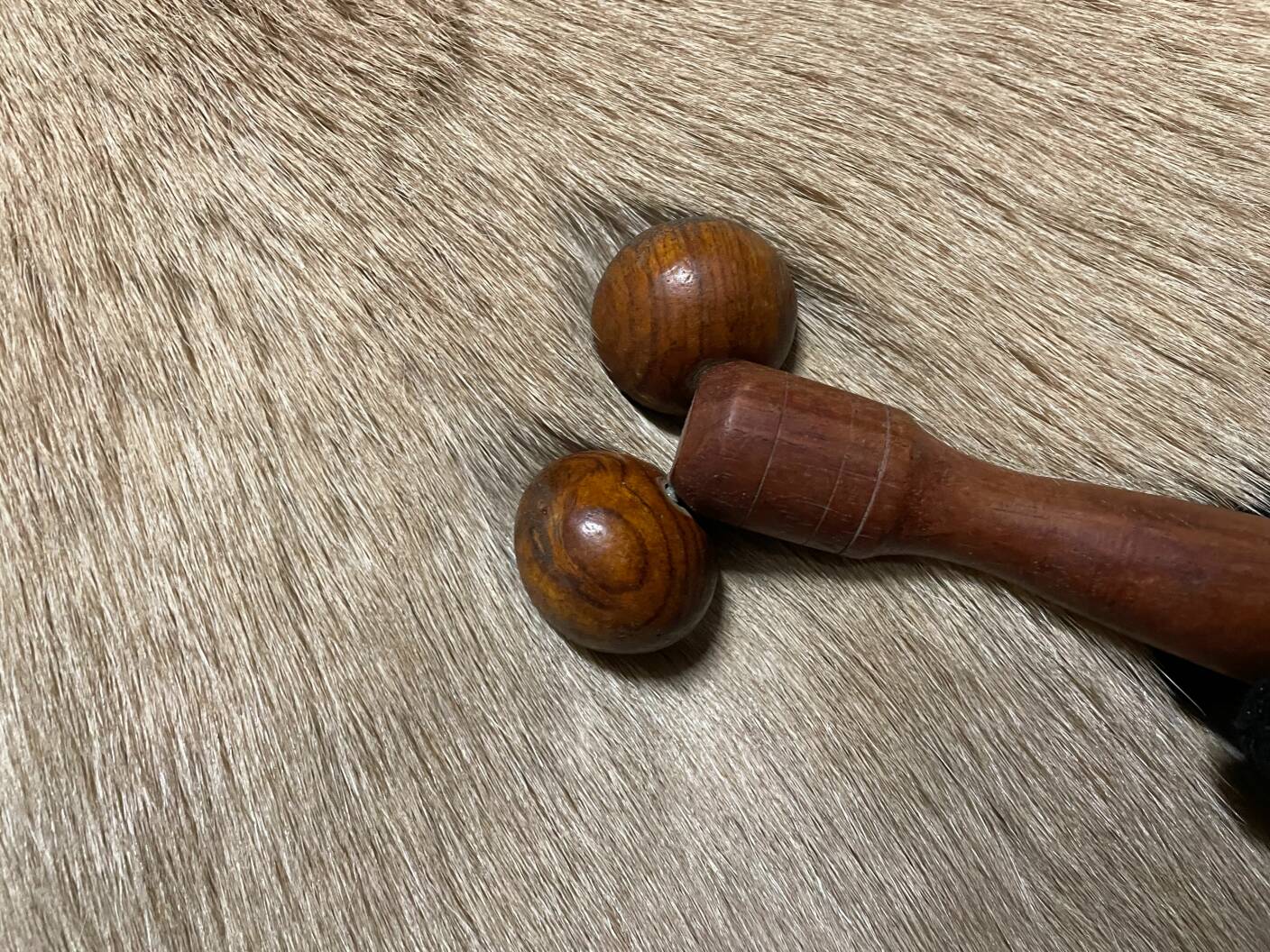
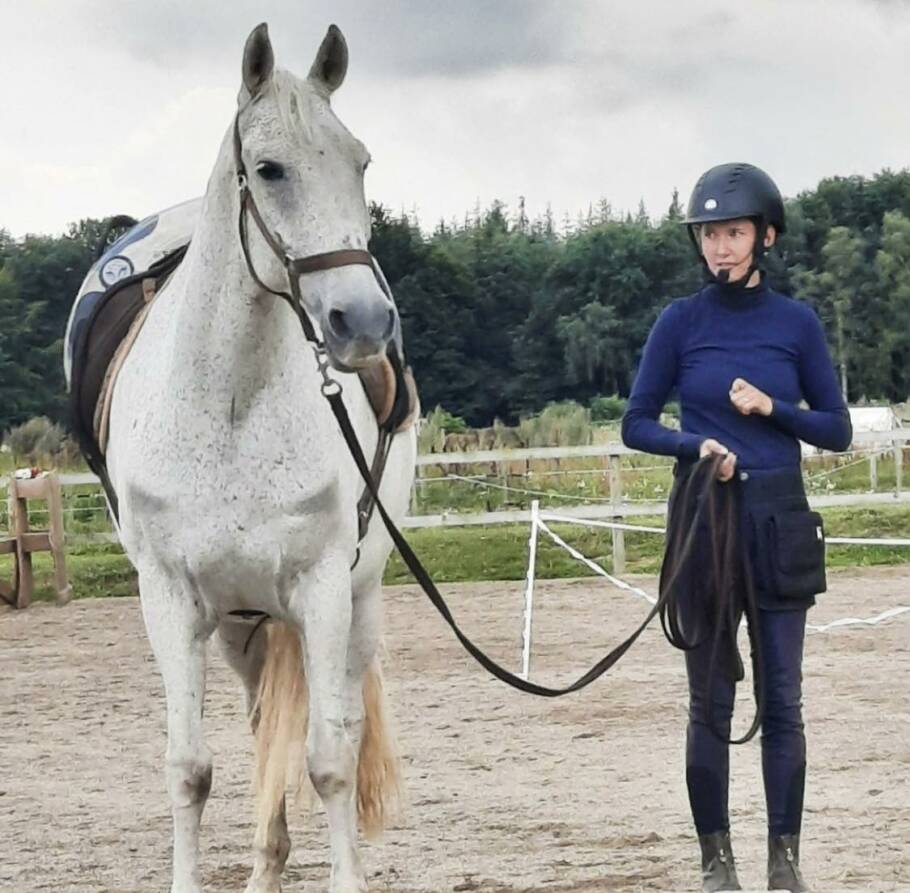
An aqua bag can be a gentle way to train your horse. Photo: Ellen Sauer
Place the balls underneath your seatbones on the saddle. Once placed correctly sit down on the saddle as normal. Photo: Cæcilie Kallehave Jensen

Playing with a pilates ball can increase your horse's mobility and curiosity. Photo: Shutterstock
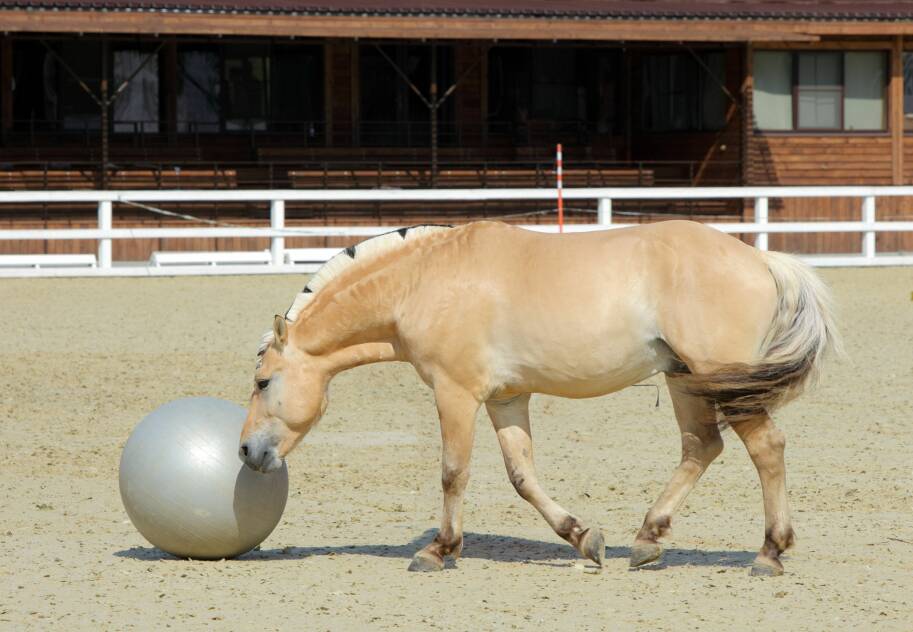
The exercise on the mat contributes to training your horse's perception. Perception encompasses the way both we and the horse sense the world, perceiving through sight, hearing, touch, taste, or smell.
In proprioception training, the goal is to enhance the horse's coordination and balance by strengthening its body awareness through sensorimotor exercises, both from the ground and from the saddle. The increased focus on body awareness can also stimulate mental exercise for many horses because they suddenly have to feel and use their bodies in a different way than they might be used to.
"Proprio" is simply a shortening of proprioception. Proprioception is a sense that provides information to the brain on how our limbs should react in a given situation based on the sensory input received. The brain processes these inputs, allowing it to instruct the body on where, for example, our legs should be placed depending on the sensory impression the ground provides. Some parts of the body have more receptors, making them particularly suitable for proprioception training. For horses, for example, the hindquarters of the hooves can contain many sensitive receptors.
What is proprio?
The pony Fazion practicing standing on the mat. Photo: Ellen Sauer
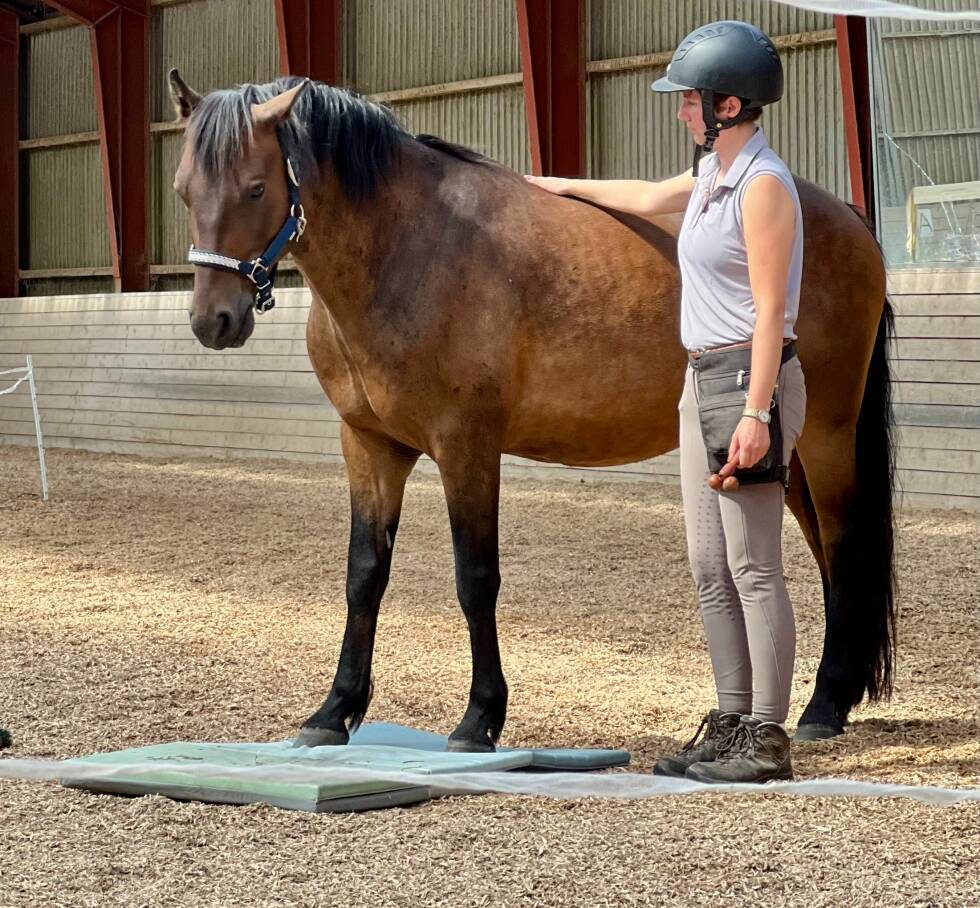
You can use both thin yoga mats and slightly thicker mats. Place the mat in the riding arena or in the stable and let your horse sniff and explore it before asking it to step on it. For some horses, feeling the sudden change in the surface can be intense. It challenges the small muscles in your horse's body as it strives to maintain balance. However, avoid using your most expensive mat, as it may get damaged, especially if the horse paws or is wearing shoes.
1. Fitness Mats



Sources:
Let your horse sniff the aqua bag the first time and put it on without weight initially – possibly without a saddle as well. Remove the aqua bag when the horse is calm and comfortable with it.
Hold onto the aqua bag all the time, and preferably have someone help hold the horse, so you can quickly remove the aqua bag and calm the horse if it panics.
Once the horse is comfortable with the aqua bag on its back, you can try placing a saddle on and attaching the aqua bag to it, asking the horse to move forward and possibly fastening it loosely to the saddle.
If your horse is comfortable with the above, you can repeat the same procedure with water in the aqua bag. You do not need to fill it up completely – especially not at the beginning. Experiment with what works for you.
Be aware that your horse may react to both the feeling of weight and the sloshing sound of water in the aqua bag.
Once your horse is comfortable with the aqua bag on its back, you can start working with the horse and activate its back in the way you usually do. This could be through pole work or similar. Since there will be water on both sides of an aqua bag, it demands your horse's body awareness, abdominal muscles, coordination, and balance. Therefore, it can be relatively challenging training for your horse. Thus, you should not train with the aqua bag for long intervals.
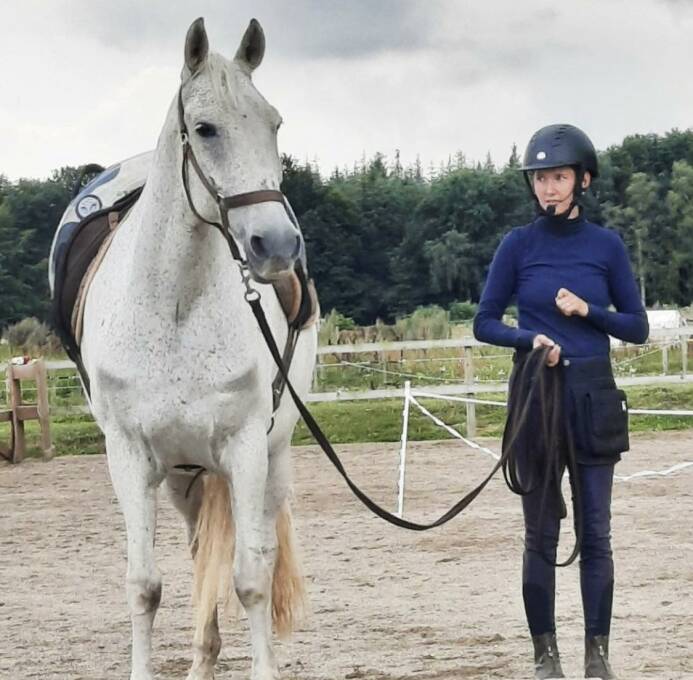
An aqua bag can be a gentle way to train your horse. Photo: Ellen Sauer
The aqua bag was originally developed to improve the movements of professional wrestlers in Bulgaria. Normally they are filled with sand, but the version that can be used for your horse should be filled with water. It might sound a bit strange, that you can use a wrestling tool for your horse, but nevertheless, an aqua bag is a gentle way to train your horse.
That is, if you for instance are breaking in your horse, are rehabilitate after an injury, or you just want to train its back muscles in a gentle way, you can experiment with an aqua bag. It can easily be filled with water and can weigh up to 17 kg.
5. Aqua bag
As with many other kinds of horse training, you should proceed slowlY
Benefits of massage
Increases and improves blood circulation
Increases lymph circulation
Raises body temperature
Lowers blood pressure (by affecting the autonomic nervous system)
Increases elasticity in muscles and tendons
Prevents various issues in the entire musculoskeletal system
Increases interaction and closeness between you and your horse. Additionally, it helps improve your own condition when performing the massage.
There are many different types of massage tools that you can use on your horse, but it is recommended to consult a professional before you start. Photo: Cæcilie Kallehave Jensen
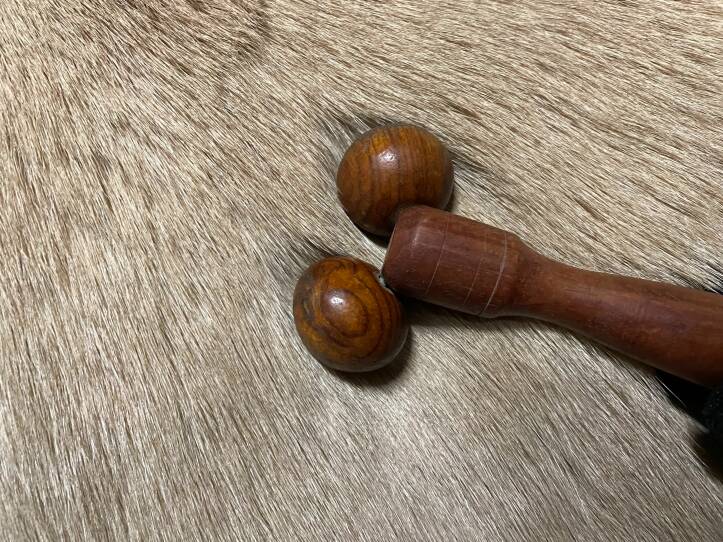
It is not only humans who enjoy the benefits of massage; your horse will likely appreciate a session with a massage tool. However, it can never replace a massage from a trained equine bodyworker. Instead, it can be used as a supplement to your daily grooming and training routine.
You can experiment with using it in your groundwork or before riding. While massage often has a relaxing effect on many horses, it can also be used to activate your horse during groundwork by stimulating blood circulation. Before you begin, however, make sure you know where and how to massage the horse to avoid causing harm. Consult a trained body therapist for help.
4. Massage toolS
If your horse is not very interested in playing with the Pilates ball, you can try training by yourself.
Use Pilates Ball as a Rider
Place the balls underneath your seatbones on the saddle. Once placed correctly sit down on the saddle as normal. Photo: Cæcilie Kallehave Jensen

When your horse is comfortable standing on the mat, you can gradually build upon it. For example, challenge your horse's balance on the mat by asking it to lift one leg or perform certain stretching exercises. Experiment with exercises that you would typically ask your horse to do from the ground. You can also try placing different numbers of legs on the mat, folding it completely or halfway to see how it affects the horse's body.
If the mat has a fun colour, it can also serve as environmental training for many horses. Therefore, you can experiment with placing it in different locations around the arena or on the track whilst riding. This way, your horse will suddenly experience how otherwise familiar surroundings may look different, because of the mat. This can help strengthen your horse's focus and concentration once it realizes that the distracting element is not dangerous.
Unlike the Pilates ball, smaller balls can be used to increase the rider's body awareness. Place the small balls under the rider's seat in the saddle, helping you activate your pelvis and improve your seat.
While your horse is walking to warm up, try placing two small balls just under your seat bones. This will loosen the muscles around the seat bones and thighs, making it easier for you to get down and around your horse with your legs. Additionally, you will become more upright, providing a better – and healthier – position in the saddle, benefiting both you and your horse.
3. Balls underneath the seat
Most horse people have probably seen how amusing it can be when a horse runs around after a large Pilates ball. If the horse is comfortable with it and approaches the ball on its own, it can have a lot of fun with a Pilates ball – but it is not just for fun! Incorporating the Pilates ball into your training can make your horse more curious, especially when it nudges the ball with its nose. Moreover, it helps improve your horse's mobility when making large movements to push the ball.
However, introducing the ball requires gradual adaptation and you should ensure that your horse doesn't bite the ball. Also, monitor your horse to ensure it does not play too vigorously with the ball, such as pawing or jumping on it, as the ball can easily break.
Of course, the horse should never play alone with the ball without supervision! Always proceed slowly when introducing the ball to the horse. Many horses can be startled both by the sight of the ball and the sound it makes when rolling. Experiment, and feel free to participate in the ball game with your horse! This can also help strengthen the relationship between you and your horse. Especially if you play ball towards each other – but it may require some training (especially if you're not a talented soccer player).
2. Pilates Ball
Playing with a pilates ball can increase your horse's mobility and curiosity. Photo: Shutterstock
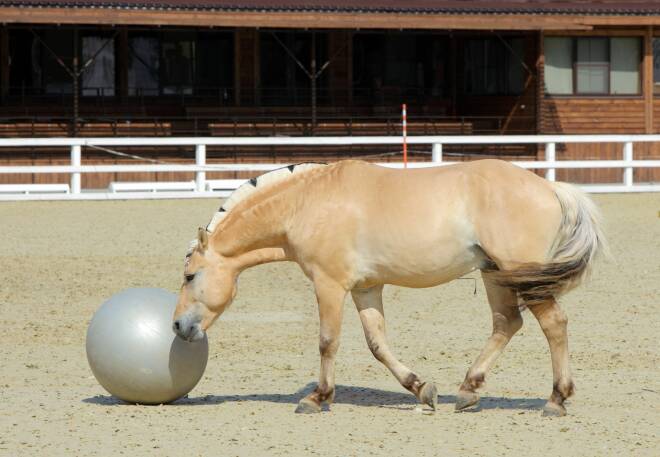
Proceed cautiously if you use a massage tool. If your horse shows any signs of discomfort, always stop and respond – and possibly have it checked by a veterinarian. Never massage – with or without a tool – on your horse immediately after training, as it can be painful for the horse's muscles.
If your horse is comfortable with it, you can try running the massage tool gently over the horse and see if you can activate different parts of the body through touch. Then try to get your horse to move. Watch for changes in your horse's movements. Perhaps the movements have become larger and more powerful – but the opposite can also be an option.

The pony Fazion practicing standing on the mat. Photo: Ellen Sauer
The exercise on the mat contributes to training your horse's perception. Perception encompasses the way both we and the horse sense the world, perceiving through sight, hearing, touch, taste, or smell.
In proprioception training, the goal is to enhance the horse's coordination and balance by strengthening its body awareness through sensorimotor exercises, both from the ground and from the saddle. The increased focus on body awareness can also stimulate mental exercise for many horses because they suddenly have to feel and use their bodies in a different way than they might be used to.
"Proprio" is simply a shortening of proprioception. Proprioception is a sense that provides information to the brain on how our limbs should react in a given situation based on the sensory input received. The brain processes these inputs, allowing it to instruct the body on where, for example, our legs should be placed depending on the sensory impression the ground provides. Some parts of the body have more receptors, making them particularly suitable for proprioception training. For horses, for example, the hindquarters of the hooves can contain many sensitive receptors.
What is proprio?
Pilates and exercise balls are probably not something you immediately associate with the stable. However, in reality, these – and many other items from the gym – can also be used in the stable. Read on and discover what and how!
By Cæcilie Kallehave Jensen. Coverphoto: Ellen Sauer
You can use both thin yoga mats and slightly thicker mats. Place the mat in the riding arena or in the stable and let your horse sniff and explore it before asking it to step on it. For some horses, feeling the sudden change in the surface can be intense. It challenges the small muscles in your horse's body as it strives to maintain balance. However, avoid using your most expensive mat, as it may get damaged, especially if the horse paws or is wearing shoes.
1. Fitness Mats
Fitness equipment that can be
used in the stable
Maybe you are already using the large Pilates ball when doing groundwork with your horse. But there is actually much more fitness equipment that you can use in the daily training of both you and your horse. Here are five suggestions for fitness equipment of varying difficulty levels that you and your horse can try to incorporate into your daily routine.

